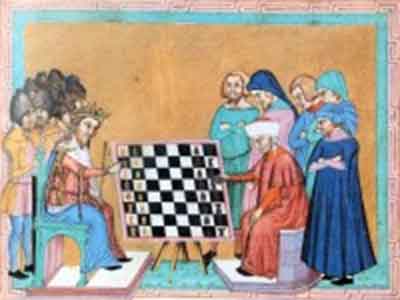> Les peintres à la fin du Moyen Âge et début renaissance
> Littérature du Moyen Age
> Musiques du Moyen Age
Se déplacer au Moyen Age : exposition musée de Cluny - première partie - deuxieme partie
Les femmes au Moyen Age: première partie - deuxième partie
L'invention du corps de mode à la fin du Moyen Age
Retour vers le Moyen Age (1/4) :...
> Les peintres à la fin du Moyen Âge et début renaissance
> Littérature du Moyen Age
> Musiques du Moyen Age
Se déplacer au Moyen Age : exposition musée de Cluny - première partie - deuxieme partie
Les femmes au Moyen Age: première partie - deuxième partie
L'invention du corps de mode à la fin du Moyen Age
Retour vers le Moyen Age (1/4) : Chrétien de Troyes
Retour vers le Moyen Age (2/4) : La Divine Comédie de Dante
Retour vers le Moyen Age (3/4) : Maître Eckhart
Retour vers le Moyen Age (4/4) : Thomas d'Aquin
la cartographie médiévale cartes 4/4 Débat historiographique
La spiritualité au Moyen Âge avec Alain de Libera et Jean-René Valette
L’armée du roi de France au Moyen Age
Exposition à la cité des Sciences jusqu'au 6 août 2017 :
Exhibition at the Cité des Sciences until 6 August 2017 :
Everyday campaigns
"Archaeology shows a completely new picture of rural life in the Middle Ages, which affected 95% of the population. Neither objects of permanent famine nor theatres of instability, the countryside was a privileged place to live, where work and resource management were particularly dynamic. Many foreigners, refugees from a declining Roman Empire, brought their own culture which merged with that of the inhabitants already settled. A multitude of vestiges illustrate this country life and bear witness to the daily life of the peasants, about whom the texts speak little".
The elites in the Middle Ages
"The archaeological excavations bring a new vision of the elites. In particular, they reveal that the castle was not the only place where the secular elites lived, who also occupied more modest or rustic habitats. They also show the complexity of the medieval social hierarchy and vassalic ties. Around the emperors, kings, princes and their entourage, gravitated rural elites who were subordinate to them. In the second Middle Ages, the knights came from the lower nobility and wealthy peasants could exercise a certain authority".
Invasions or migrations
"Contrary to popular belief, there were no barbarian invasions or violent and rapid conquests in the Middle Ages, but great slow and progressive migratory movements, which began as early as the 2nd century. The population of the early Middle Ages gradually mixed and the peoples from the East and the North merged their culture with the Gallo-Roman culture, as can be seen in the funerary practices, skills and objects. The weapons, clothing, jewellery and accessories deposited in the tombs next to the bodies are valuable sources of information for archaeologists".
People, landscapes and resources
"Far from the cliché of a Middle Ages of peasants subjected to a hostile nature, the archaeological discoveries made on the sites of the early Middle Ages show extraordinarily inventive medieval societies in the development of nature and the management of energy resources. They transformed wild spaces with agriculture and stockbreeding, built ponds to raise fish, exploited and managed the forest, developed salt marshes, dug mines, developed rivers to feed mills... And these achievements are still clearly visible in our current landscapes".
Travels and exchanges
"In the Middle Ages, peasants, monks, merchants, pilgrims, soldiers, princes, craftsmen or scholars travelled throughout Europe and sometimes ventured beyond. Their motivations were commercial, religious, military or political. People and goods circulate, as do ideas.
Greco-Arabic manuscripts travelled the spice and silk routes. Translated, they enrich knowledge in the West. Traders from Africa and the Islamic world meet each other. These exchanges between continents broadened the horizon of Europe. They influence culture and technology. "
Cities of the Middle Ages
"Archaeological discoveries reveal a great diversity of settlements from the early Middle Ages onwards. Cities are multipolar religious, political and economic centres, each depending on a different lord. They are often strategically located, near an estuary, at the crossroads of rivers or roads. In the 12th and 13th centuries, the organisation of towns evolved. The rise in power of municipal powers can be observed, leading, from the 14th century onwards, to the construction of town halls and enclosures bringing together different districts".
Translated with www.DeepL.com/Translator (free version)
Subcategories
medieval coats of arms

Blazons made of reconstituted stone, with a hanging system back. Paints and patinas how old wooden handmadeWe can realize your crest, logo, brand: contact us
Heraldry appeared in chivalry to the twelfth century, it has spread throughout Western society: nobles, clergy, burghers, peasants and guilds. coats of arms are simple and easily identifiable. It is a family identification system (the coat of arms is transmitted by inheritance) and human communities, making it a system of recognition and identification. Example: Blazon of CunninghamGames of the Middle Ages

The Form of Cury
14,50 €



